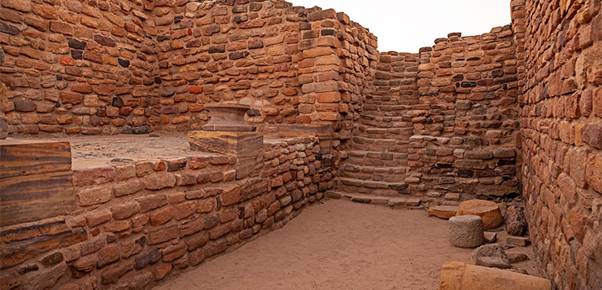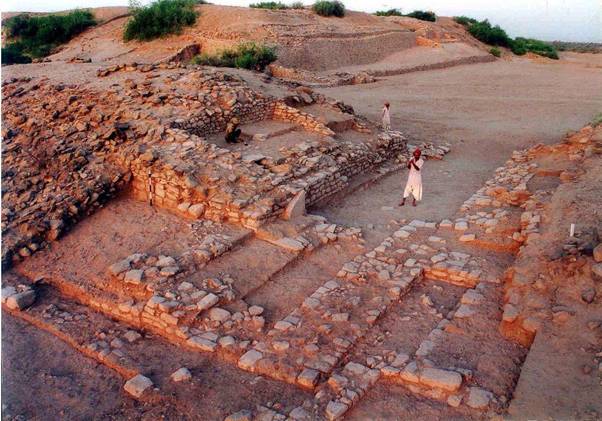UNESCO inscribes Dholavira as World Heritage Site
July 27, 2021
Bhuj: Dholavira, an ancient Harappan city in Kutch district of Gujarat has been inscribed on the UNESCO (United Nations Educational, Scientific and Cultural Organization)’s World Heritage list. This announcement was made today by UNESCO. The World Heritage Committee’s 44th session chaired from Fuzhou (China) is taking place online during 16 to 31 July, combining current work and issues left outstanding since last year, when the annual meeting was postponed due to COVID-19.
🔴 BREAKING!
Dholavira: A Harappan City, in #India🇮🇳, just inscribed on the @UNESCO #WorldHeritage List. Congratulations! 👏
ℹ️ https://t.co/X7SWIos7D9 #44WHC pic.twitter.com/bF1GUB2Aga
— UNESCO 🏛️ #Education #Sciences #Culture 🇺🇳😷 (@UNESCO) July 27, 2021
UNESCO has earlier declared Champaner – Pavagadh in Central Gujarat, Rani ni Vav in Patan in North Gujarat and historic city of Ahmedabad as World Heritage Sites. DeshGujarat
It is a matter of immense pride that the @UNESCO has conferred the World Heritage tag to Dholavira, a Harappan city in Kutch. This shows the firm commitment of our Honourable Prime Minister Shri @narendramodi ji towards promoting Indian culture and heritage. https://t.co/kDxflSQG4j pic.twitter.com/DJnuBYFyNU
— Vijay Rupani (@vijayrupanibjp) July 27, 2021
India gets its 40th World Heritage Site
Absolutely delighted by this news.
Dholavira was an important urban centre and is one of our most important linkages with our past. It is a must visit, especially for those interested in history, culture and archaeology. https://t.co/XkLK6NlmXx pic.twitter.com/4Jo6a3YVro
— Narendra Modi (@narendramodi) July 27, 2021
India’s nomination of Dholavira, the Harappan City in the Rann of Kutch, Gujarat has been inscribed on UNESCO’s World Heritage list. India submitted the nomination dossier for Dholavira: A Harappan City to the World Heritage Centre in January, 2020. The site was on the UNESCO’s tentative list since 2014. Dholavira: a Harappan city, is one of the very few well preserved urban settlements in South Asia dating from the 3rd to mid-2nd millennium BCE.
Prime Minister Shri Narendra Modi tweeted, “Absolutely delighted by this news. Dholavira was an important urban centre and is one of our most important linkages with our past. It is a must visit, especially for those interested in history, culture and archaeology.”
The Union Minister of Culture, Tourism and Development of North Eastern Region (DoNER) Sri G Kishan Reddy shared this news on Twitter shortly after the announcement. This follows a few days after the Rudreswara Temple, (also known as the Ramappa Temple) at Palampet, Mulugu district, Telangana State becoming the 39th World Heritage Centre in India.
Shri G Kishan Reddy tweeted, “It gives immense pride to share with my fellow Indians that Dholavira is now the 40th treasure in India to be given @UNESCO World Heritage tag. Another feather in India’s cap as we now enter the Super-40 club for World Heritage Site inscriptions.”

With this successful nomination, India has 40 world heritage properties overall, which includes 32 cultural, 7 natural and one mixed property. The Union Minister for Culture was referring to the countries that have 40 or more World Heritage sites and apart from India, this now contains Italy, Spain, Germany, China and France. The Minister also observed in his tweet how India has added 10 new world Heritage sites since 2014, and this is testimony to the Prime Minister’s steadfast commitment in promoting Indian culture, heritage and the Indian way of life.

Shri G Kishan Reddy tweeted, “Today is a proud day for India, especially for the people of Gujarat. Since 2014, India has added 10 new World Heritage sites – one fourth of our total sites. This shows PM @narendramodi’s steadfast commitment in promoting Indian culture, heritage and the Indian way of life.”
About the Harappan city of Dholavira
Dholavira: a Harappan city, is one of the very few well preserved urban settlements in South Asia dating from the 3rd to mid-2nd millennium BCE. Being the 6th largest of more than 1,000 Harappan sites discovered so far, and occupied for over 1,500 years, Dholavira not only witnesses the entire trajectory of the rise and fall of this early civilization of humankind, but also demonstrates its multifaceted achievements in terms of urban planning, construction techniques, water management, social governance and development, art, manufacturing, trading, and belief system. With extremely rich artefacts, the well preserved urban settlement of Dholavira depicts a vivid picture of a regional centre with its distinct characteristics that also contributes significantly to the existing knowledge of Harappan Civilization as a whole.
The property comprises two parts: a walled city and a cemetery to the west of the city. The walled city consists of a fortified Castle with attached fortified Bailey and Ceremonial Ground, and a fortified Middle Town and a Lower Town. A series of reservoirs are found to the east and south of the Citadel. The great majority of the burials in the Cemetery are memorial in nature.
The configuration of the city of Dholavira, during its heyday, is an outstanding example of planned city with planned and segregated urban residential areas based on possibly differential occupational activities, and a stratified society. Technological advancements in water harnessing systems, water drainage systems as well architecturally and technologically developed features are reflected in the design, execution, and effective harnessing of local materials. Unlike other Harappan antecedent towns normally located near to rivers and perennial sources of water, the location of Dholavira in the island of Khadir was strategic to harness different mineral and raw material sources (copper, shell, agate-carnelian, steatite, lead, banded limestone, among others) and to facilitate internal as well as external trade to the Magan (modern Oman peninsula) and Mesopotamian regions.
Dholavira is an exceptional example of a proto-historic Bronze Age urban settlement pertaining to the Harappan Civilization (early, mature and late Harappan phases) and bears evidence of a multi-cultural and stratified society during the 3rd and 2nd millennia BCE. The earliest evidence can be traced back to 3000 BCE during the early Harappan phase of the Harappan Civilization. This city flourished for nearly 1,500 years, representing a long continuous habitation. The excavated remains clearly indicate the origin of the settlement, its growth, zenith and the subsequent decline in the form of continuous changes in the configuration of the city, architectural elements and various other attributes.
Dholavira is an outstanding example of Harappan urban planning, with its preconceived city planning, multi-layered fortifications, sophisticated water reservoirs and drainage system, and the extensive use of stone as a building material. These characteristics reflect the unique position Dholavira held in the entire gamut of Harappan Civilization.
The expansive water management system designed to store every drop of water available shows the ingenuity of the people to survive against the rapid geo-climatic transformations. Water diverted from seasonal streams, scanty precipitation and available ground was sourced, stored, in large stone-cut reservoirs which are extant along the eastern and southern fortification. To further access water, few rock-cut wells, which date as one of the oldest examples, are evident in different parts of the city, the most impressive one being located in the citadel. Such elaborate water conservation methods of Dholavira is unique and measures as one of the most efficient systems of the ancient world.
Related Stories
World Heritage Status: UNESCO team to examine Dholavira in upcoming September
PM Narendra Modi's France speech addressing Indian community at UNESCO HQ in Paris
Ahmedabad city inscribed as UNESCO World Heritage City
UNESCO team starts evaluating sites in Ahmedabad for heritage tag
UNESCO declares Rani ki Vav as World Heritage Monument
Discussion on Rani Ki Vav at UNESCO meet likely on Sunday
UNESCO team visits Ranki Vav in Patan, bright chances for World Heritage Site status
Modi to inaugurate AMC-UNESCO heritage conference
Recent Stories
- Smritivan Earthquake Memorial of Kutch Awarded at UNESCO's 2024 Prix Versailles
- Khel Mahakumbh 3.0 to be held from 5th Dec 2024 to 31st Mar 2025 in Gujarat
- Explosion at Detox India Pvt. Ltd. in Ankleshwar claims four lives
- Flying knives: Surat youth dies after kite string slashes his throat on overbridge
- IFFCO starts exporting Nano Urea to Sri Lanka, Nepal, Bhutan, and Brazil
- ACB Gujarat nabs Dy. Mamlatdar-cum-Circle Officer for accepting bribe
- Gujarat recorded over 9.53 lakh animals in 2023; attracted 18–20 lakh migratory birds in 2024
